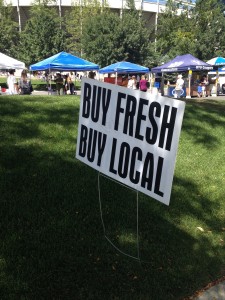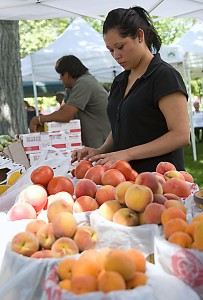
Jessica Breton woke up on a Saturday morning and drove from Pleasant Grove to Provo, excited to purchase some fresh produce from local growers at the farmers market, but was concerned when she saw that the majority of the market vendors were selling crafts.
Farmers markets in Utah Valley spread from Thanksgiving Point to Spanish Fork, but actual farmers’ involvement in these markets are limited; the majority of vendors sell handicrafts. Many patrons come for produce and may be disappointed by the ratio of craft to grower vendors.
Farmers markets continue to thrive across the United States despite the trend of more craft than farmer vendors. There were close to 8,500 farmers markets nationwide in 2014, more than doubling the number from a decade ago, according to a study done by the United States Department of Agriculture.
The increased number of farmers markets has, ironically, not led to an increased involvement of farmers. A casual tally of a recent Provo farmers market found that only seven of the 70 booths, a mere 10 percent, sold fresh produce from local growers.
Perhaps the increased number of craft vendors can be attributed to the recent trend of do-it-yourself, or DIY, projects. Shops such as Etsy that sell handmade products are becoming more and more popular due to this trend. A recent search on Etsy found that there are over 730,000 active shops currently on the site.
DIY and Buy Local Movements
The do-it-yourself craze has made farmers markets more accessible to handicraft vendors. Directors of both the BYU and Provo farmers markets said all craft vendors are required to make the project they’re selling by hand, rather than just resell something they’ve purchased elsewhere.
Craft vendor LaDonna Lobendahn said she has noticed that the Provo Farmers Market gains more craft vendors each year, and feels that it will continue. Lobendahn also said she thinks patrons come for produce, but are attracted to crafts as well. She is grateful for the trend because “it helps me provide for my family,” providing an economic incentive to participate.
Lochsley Allred sells knit hats at BYU’s farmers market and through her Etsy shop, and mentioned that she enjoys the opportunity to sell her products at the market. “There has been a shift for more artsy crafty things and it seemed like it would be a good place to sell them,” Allred said. She added that she’s noticed a big “buy local” movement happening, and she feels that applies to handicrafts as well as produce.
Alan Clark, produce manager at Lolo’s Fresh Food Warehouse in Provo, said that their store sells locally grown produce, and he has noticed that customers appreciate “the fact that it’s going to be fresher.” Clark said that there’s something special about purchasing local produce that has been picked earlier that day. He also said that only one of their suppliers also sells produce at a farmers market, likely because farmers markets are on a smaller scale.
Growers and Patrons Respond to the Trend
Lori Stubbs, a local grower, participates in both the BYU and Provo farmers markets. She said she does not feel that the craft vendors have a negative effect on the market–she actually feels they help the cause. “If the craft people get more people to the market, it’s better for everyone,” Stubbs said. She also said that she doesn’t feel like she’s in competition with craft vendors because their products are so different.
Another grower, Provo resident Eilene Scott, worked hard to get a good crop to sell at the Provo farmers market and feels that the trend of more craft than produce vendors has a negative impact. “I think it takes away from the farmers,” Scott said. “Crafts have their place, but there should be a limit.” Scott added that she hopes more growers will choose to participate in the future. “I don’t think people realize how time consuming and expensive it is for us [growers],” Scott said.
The increased number of craft vendors at farmers markets also affects the patrons. Jessica Breton lives in Pleasant Grove, but often travels to Provo for the city’s farmers market. “I come for the produce. For me personally, I skip the crafts,” Breton said. She added that she is concerned about the proportion of craft to farmer vendors. “I believe that a farmers market should be about produce.”
Some patrons, however, enjoy the variety of booths. Provo resident Charleen Doman said she attends both the BYU and Provo farmers market sporadically throughout the summer. “I come for the mango salsa,” Doman said. She also said that she isn’t bothered by all the craft vendors she sees at both farmers markets.
Kevin Garver, chairman of the board for the Provo farmers market, said that although people may come for the produce, they are attracted to the handicraft booths. “Most of our patrons will walk through first and purchase produce, but with arts and crafts they’ll wait a week and come back to buy it the next week,” Garver said, indicating that the handicraft booths bring people to the market. He added that the percentage of growers that participate in the Provo farmers market typically hovers around 20 percent.
Keeping Farmers Involved

BYU concessions general manager Aaron Black has helped with BYU’s farmers market since it began five years ago. He said they saw a need for a grower-based farmers market after seeing more and more craft vendors become involved in other farmers markets. “I call them flea markets,” Black said. “We don’t even go to other farmers markets anymore after seeing a market with 70 vendors have only three growers.”
BYU’s farmers market has put in place limits as a counter-move to the growing number of craft vendors at other farmers markets. “We have a strict limit of having 50 percent growers, 30 percent craft, 10 percent food, and 10 percent baked goods,” Black said. He added that there is currently a waiting list of 20 craft vendors that will not be let in the market unless more growers are added as well. “Growers appreciate our market because we focus on them,” Black said.
Matt Hargreaves, vice president of communications for the Utah Farm Bureau said that nowadays people are very removed from the source of their food, which makes growers at farmers markets even more valuable.”Farmers markets are a great venue for farmers to connect with people who eat their food.” Hargreaves encourages farmers to participate and help increase the number of growers involved in the markets.
Hargreaves also said his organization sponsors two farmers markets that sell exclusively produce; craft vendors are turned away if they ask to be included. “People love that it’s food only, not trinkets and other stuff,” Hargreaves said. He mentioned that grower participation in farmers markets also depends on the area because “some people only grow as a hobby.”
If limits continue to be placed on the amount of craft vendors allowed to participate in farmers markets, then waking up on a Saturday morning to attend the market doesn’t have to be disappointing for patrons, like Jessica Breton, who come solely for produce.




